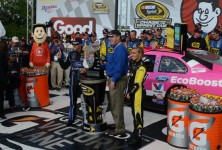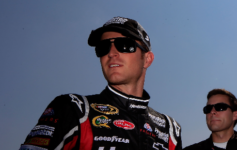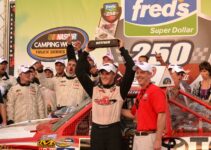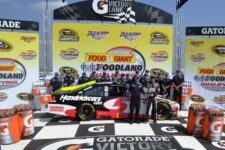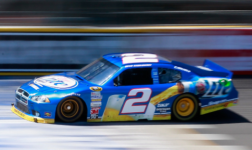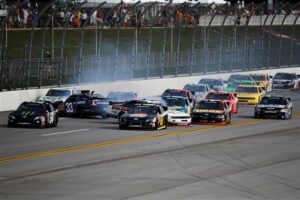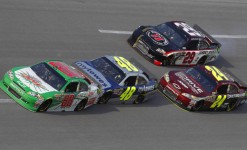[media-credit id=22 align=”alignright” width=”221″]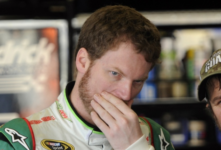 [/media-credit]Sorry Larry’s parody was removed……. due to it being a little too controversial. It was meant with no disrespect, just a take on Earnhardt’s unusual season and not the serious situation on hand.
[/media-credit]Sorry Larry’s parody was removed……. due to it being a little too controversial. It was meant with no disrespect, just a take on Earnhardt’s unusual season and not the serious situation on hand.
Below is the official Press Release:
NASCAR SPRINT CUP SERIES
BANK OF AMERICA 500
CHARLOTTE MOTOR SPEEDWAY
TEAM CHEVY DRIVER PRESS CONFERENCE TRANSCRIPT
OCTOBER 11, 2012
DALE EARNHARDT JR., NO. 88 AMP ENERGY/NATIONAL GUARD CHEVROLET met with media to discuss the fact that he will not be competing at this weekend’s race at Charlotte Motor Speedway nor at next week’s race at Kansas Speedway after being diagnosed with a concussion following the Oct. 7 race at Talladega Superspeedway. Also included in the discussion: Rick Hendrick, Owner of Hendrick Motorspots, Steve Letarte, Crew Chief, and Dr. Jerry Petty, neurosurgeon. Full Transcript:
KERRY THARP: Joining us up front we have Steve Letarte, crew chief of the No. 88; Dale Earnhardt, Jr., driver of the No. 88; team owner Rick Hendrick; and Dr. Jerry Petty, neurosurgeon. At this time I’m going to call on Dale Earnhardt, Jr., who has some things he’d like to share with everyone.
DALE EARNHARDT, JR.: I guess I’ll just start out with where this all kind of began. We had a test at Kansas about five weeks ago, and we blew a right front tire going into Turn 1, and I remember everything about that accident and everything after that accident, but I knew that I didn’t feel — you know your body, and you know how your mind works, and I knew something was just not quite right.
But I decided to just try to push through and work through it. I’d had concussions before and knew exactly kind of what I was dealing with.
I felt pretty good after a week or two and definitely 80, 90 percent by the time the Chase started, and by the time we got to Talladega I felt 100 percent, felt really good.
And then the accident at the end of that race, I was hit in the left rear quarter panel, and it was sort of an odd kind of a collision where the car spun around really quick and just sort of disoriented me, and I knew that I had sort of regressed and had a bit of a setback and knew — again, you know how your body is and you know when something is not quite right, and I knew as soon as it happened that I had reinjured myself, for lack of a better way to describe it.
It didn’t feel — it was not even half of the impact that I had at Kansas, but it was enough to cause me some concern.
So I went a couple days wondering how my body would react and sort of waiting for it to process what was happening. About Wednesday I was still having some headaches, just that was really the only symptoms that I was having was the headaches. So I took it upon myself to — I contacted my sister, and we talked about seeing a neurosurgeon, and we ended up getting steered toward Dr. Petty. Met with him, ran through a couple tests, everything was checking out, and did an MRI, everything looked good there. But I was really honest with him about how I felt and honest with him about the whole process from Kansas all the way on.
He spent the night thinking about what we discussed and everything that we did on Wednesday and couldn’t clear me to race this weekend. I trust his opinion. That’s why I went to see him. He’s been a good friend of mine for a long time and has helped me through a lot of injuries before, so I believe when he tells me I don’t need to be in the car and I need to take a couple weeks off that that’s what I need to do.
That’s pretty much the extent of it. I got a lot of support from my team. I’m excited about their opportunities the next couple weeks with Regan, and just looking forward to getting this cleared up and getting back in the car as soon as I can so I can get back to work with my team and getting back to competing on Sundays.
Q. Dale, did you see anyone for the Kansas — the issues you had at Kansas, and if you knew immediately that something was off on Sunday, why did you wait until Wednesday?
DALE EARNHARDT, JR.: No, I didn’t see anybody at Kansas. I was — I regret not seeing somebody after that happened. I was stubborn, and I’d had concussions before and knew what I was — thought I knew what I was dealing with and felt like that I was capable of doing my job.
I had called Steve. We talked about how I was feeling, and I told him that I really — I felt pretty good, but I really wouldn’t know if I would be able to compete until I got into the car. When you have a concussion, the symptoms can be really mild, and then they’ll typically go away after a couple days and you feel perfectly normal. But then when you get in a car and you go around the track at a high rate of speed, you start to understand that some things just aren’t quite where they need to be and some reactions just aren’t as sharp.
You really can’t get a measurement of that until you’re in the car. You can’t even — there’s just no way of knowing until you can drive. I wasn’t willing to — with the Chase coming up, I didn’t know how difficult — if I was to volunteer myself to medical attention and be removed from the car, I didn’t know how difficult it would be to get back in. But I was honest with Steve and told Steve, I said, when we get to Atlanta and if I don’t feel good, I’m going to be honest with you and tell you that we need to have something as a backup plan for me to get out of the car. I wasn’t going to drive the car if I felt like I was going to deal my crew chief and my team a shorthand that weekend.
That’s kind of the same reason I waited until Wednesday. The shot at Kansas was — I think we got the data, but it was around 40 G’s, and the shot at Talladega was only around 20 G’s. It wasn’t really that big of a wreck, and the fact that I felt the way I did was what concerned me after the accident at Talladega because it wasn’t that hard of a hit.
I wanted to process how I felt over a couple days. I went to the doctor Tuesday, actually.
Anyways, we — you know, I just wanted to process what was happening, and I knew having them two concussions back-to-back was not a good thing. So I needed to go see somebody regardless of whether I wanted to get out of the car or not. Just for my own well-being, I couldn’t — if I didn’t need to go get in a race car and get hit again, I needed somebody to tell me that because I was going to have a hard time making that decision for myself. I feel perfectly fine, but I don’t want to keep getting hit in the head.
Q. Because you drove your car away at Talladega, you weren’t required to go to the care center. We’ve come a long way from where drivers would lie and not say that they have concussions or Ricky Rudd taped his eyes open. What do you feel about concussions in general, and do you think you wouldn’t have made the decision yourself to have it checked out because you were able to drive your car away at Talladega?
DALE EARNHARDT, JR.: I just felt like that once — if you have more than one in a small period of time, you need to take that quite seriously. That’s how — I mean, I had — the one in Kansas was really bad, and then to get shaken up so quickly over something to kind of trivial. That accident was — I’ve been through tons of last lap wrecks at Daytona and Talladega, and that one shook me up, and I just thought maybe I should take this seriously.
Q. Dr. Petty, Dale has been saying he kind of knows what he’s dealing with as far as concussions. What is he dealing with and what does he need to do to be cleared to race?
DR. PETTY: So far what we’ve done is Dale — the first thing he had was an impact test, which is a test that we’ve been using more and more with drivers. His exam was entirely normal except that his main thing — we were seeing him for symptoms. He had very few signs at that time. In other words, his neurological exam was normal.
We wanted to get an MRI scan, and we did an MRI that following morning, a special MRI. I think we had to wait a while to get it because we wanted to get a special method they have of looking for previous injuries and so forth. That was entirely normal. The whole — that was very encouraging.
Then we talked to Dale, and he — I couldn’t give you a better history than he just did. He had no amnesia on either side of either of the incidents, which is very important, and I think that there’s every reason to expect — what we’ll do now is we want him to have four or five days after he has no headache, and then we’ll give him some sort of test like to get his pulse rate up, see if we can provoke a headache, and then if we can’t, we’ll let him go out and drive a lap or two and see how that goes, and if that goes well, we’ll probably clear him to race.
Q. For Mr. Hendrick, you’ve been racing a long time and you’ve done it with a whole lot of different men. What level of courage does it take for someone to take it upon themselves at the highest level, when all of them talk all the time about how terrified they are that somebody is going to take their wheels, for him to walk in and admit that he had this pain?
RICK HENDRICK: Well, I think that’s one thing everybody admires about Dale is how honest and up front he is. He cares a lot about the team, his fans, and the sport in general. But when he knew that there was something not right, he went to see Dr. Petty here, and I admire him. I think a lot of guys would try to play hurt, but when the doctor tells you if you get hit again like right away, it could be catastrophic, so I think this deal has worked out extremely well as it could. I mean, we were so happy yesterday that the MRI was completely normal, no damage. We don’t have a problem there.
And for these two guys to have the kind of year they’ve had, to lead the points and get in the Chase, we’ve got a lot of years left to race, I always want to be on the side of safety, and I applaud Dale for raising his hand and going in there and getting checked out.
Q. For Dale, you said you’ve had other concussions in the past. We know there was the one in 2002. Have there been others in between then and now, and have there been other instances where you haven’t gotten it checked out and you’ve just known that the symptoms were going to clear and you’re going to be okay once you get back in the car?
DALE EARNHARDT, JR.: Well, I can’t really recall precisely every run I’ve had. Me and Dr. Petty were trying to count them the other day. But those were really mild and you were fine in 48 hours. For whatever the reason the wreck at Kansas was just really severe and really surprised me how tough it was to get past that.
I thought I was in the clear, but just that little accident at Talladega, I started having headaches and stuff immediately after the wreck, and then into the next day and into Tuesday, and I thought, man, this is pretty soon after the other accident in Kansas. I should probably take this really seriously and seek some professional opinions on this.
Typically they only last 24 to 48 hours and go away, and sometimes you don’t even — sometimes to be honest you don’t even really know you have a mild concussion.
Q. Concussions have been in the news quite a bit lately, particularly with the NFL. In light of that how much of a concern is this for your long-term health, and did that kind of play into it at all?
DALE EARNHARDT, JR.: I think that you just — I don’t think that it played into it a whole lot. When something happens to your body, I want to live a healthy life so I’m going to make sure that I’m doing the right thing, and that’s all I felt like I was doing here.
I think if I give myself time to get healed up, I can race for as long as I want to race, and that’s my objective.
RICK HENDRICK: I think the real good news is it has come to light with the NFL and Dr. Petty handles NFL guys with the Panthers, too, and there’s another doctor here, too, with him, and there’s some things they can do to help it along and protect him, and he was explaining all that. So the good news is it’s — this is kind of preventative maintenance not to take a chance and there’s no damage.
But I think when you find out that you’re okay, but if you were right away to have another one, it could be a big problem, then I think guys are going to have to pay attention to it, just like the NFL, just like I heard on SportsCenter talking this morning about two or three different people they were waiting to get cleared to play this weekend.
So as Dr. Petty said, he can’t drive until these things happen. I think it’s good that it’s — all the safety stuff we have in the cars today, this probably was a lot of — I can remember in my career broken legs, broken arms, guys sitting out for different stuff, and we don’t have that. I remember Terry Labonte having to sit out when he had that inner ear problem, and I think the good news is the cars are so safe, the medical field is so advanced, and if we do what they tell us, we shouldn’t have any trouble.
Q. For Dr. Petty, it seems like a lot of people when we talk about concussions make it seem to be a cut-and-dry thing, but in this instance, Dale Jr. talked about the tests being normal, and a lot of it seems to be him telling you the symptoms that he’s experiencing. I was just wondering in your dealing with athletes, is it mostly listening to them tell you the effects of after an incident, or is it a combination generally of test results and them telling you what’s going on?
DR. PETTY: It’s a combination in some regard. If an MRI scan or a CT scan is abnormal, then it’s no longer a concussion, it’s a hemorrhage or a contusion. By definition it’s not a concussion.
So some of the testing that’s done like the impact tests that Dale had, those are tests that we can follow, and if he should have an injury again in the future, we can use that as a baseline. What we’d want to make sure is that baseline doesn’t start to fall off and even fall off without being tested.
The period of — what he has is really called a diffuse axonal injury, and it’s something that does not show on scans, and we don’t have test that will show that other than symptoms and signs. Sometimes there will be some residual signs left over, but Dale had none of those. He had no — his eyes did what they were supposed to do; his balance tests and so forth are perfect.
The biggest — the one test, the one symptom that is more important than all the tests is headache, and as long as there’s any headache, the brain is not healed, and until that’s healed and had some time to rest and then you provoke it again and can’t make it happen again, then that’s — then you feel like you’re on the road to recovery.
Q. When you look at Eric McClure, his concussion, you look at your concussions, Brad Keselowski broke his ankle, are the cars not as safe as they need to be right now?
DALE EARNHARDT, JR.: Oh, the cars are fine. There’s just some things that you can’t control. I don’t know that you can have a race car that’s completely 100 percent safe. But there’s been so much — so many advances in the last 10 or 12 years that have made this sport incredibly safe. So I have no worries about that.
Q. Dale or Rick, was there any consideration of having you possibly set out the rest of the season as opposed to just Charlotte and Kansas at any point in time?
DALE EARNHARDT, JR.: No, not really. I would love to race this weekend, and I feel perfectly normal and feel like I could compete if I were allowed to compete this weekend. But I think that the basis of this whole deal is that I’ve had two concussions in the last four to five weeks, and you can’t layer concussions. It gets extremely dangerous.
So I really don’t want to — I think that we could easily have chosen to do that, but I’d like to get back in the car and compete as soon as I can, as soon as the doctors feel like I’m able to do that.
Q. Dale, what’s your situation going to be like in the next two weeks? Are you going to be keeping the same role as a driver and working with Regan any since he’s taking over the car? What’s your role going to be like? Is it going to change any?
DALE EARNHARDT, JR.: Well, I really don’t know. I probably need to rest and relax as much as I can, allow my brain to take a break and get some healing done. You know, Regan doesn’t need any tutoring or anything like that. He’s ready to go. He’s going to do a great job. I’m excited for his opportunity. He’s a really good guy, been a good friend of mine for a long time.
Under the circumstances I think this is a really, really neat opportunity for him, and I think that Steve and the guys will enjoy working with him.
Q. Considering the incredible season you were having, did it make it even more difficult to make this decision the first time, the second time, and is it just frustrating because of how well you and Stevie were working together?
DALE EARNHARDT, JR.: It’s frustrating. I really didn’t get to make the decision. I left it in the hands of the Docs, and I’m going to do what they tell me to do. But it’s frustrating; I just enjoy driving cars week in and week out. I enjoy being at the racetrack with Steve, so I’m going to really miss that.
Q. I know in the NFL if you have a concussion they make you sit out six or seven days before you go back in. NASCAR drivers have kind of hid this fact like Dale did after the Kansas incident. Does there need to be more stringent rules that would prevent drivers from being on the track with concussions?
DR. PETTY: We’ve patterned our rules after the NFL to a degree. We would do the same procedure about giving them five or six days without a headache and then doing provocative tests.
I don’t think that, so far as I know, they’re not allowed to go back any earlier than some of the NFL guys are allowed to go back.
Q. Dale, one question for you: I know you said you have to rest up a little bit, but will you come to the race this weekend to support the team? And for Steve Letarte, what have you had to do to the car to prepare for Regan Smith to race this weekend?
DALE EARNHARDT, JR.: Yeah, I don’t have any plans of being here this weekend. I think that I’d be more of a distraction to the team and their efforts in the race. I think they’ve got a good opportunity to have a good run this weekend, and I feel like that — to minimize the distraction would help them out.
STEVE LETARTE: As far as preparing for the car for Regan, there’s not a whole lot to do. He’s been at the shop early this morning just to sit in his seat versus Jimmie’s. We have a lot of options at the company, and he found the one that fits him the best, so we’ll probably change the seat, the pedals, just adjust things to his driving style. He’ll probably have to get on the race track to really fine-tune everything like he really wants it. They’re reasonably close to the same size, so it shouldn’t be much of a problem at all.
Q. This is for Steve: When this happened at the tire test, it sounds like there wasn’t a lot of medical staff or he didn’t go to a care center. Is that standard for these tire tests; and is that something that you think should be changed? How does that usually work?
STEVE LETARTE: Well, there was a medical staff there, and he was seen in the ambulance after his accident. I think he was seen there.
As far as the care center and what should be standard, I kind of leave that to the experts above me. I stick with crew chiefing and race cars. I don’t know if I’m really the guy that can answer that question.
I think injuries are complicated, and I think every situation can be different. We test all over the country, whether it’s a tire test or whether we’re by ourselves at a straight-line test or Nashville, any type of cars on track there’s a risk of injury. I don’t know if there’s any real — I wish it would be a cut-and-dry answer, but I don’t really think there is a cut and dry answer.
Q. Rick, can you give us a precise as best you can remember timeline on when the decision was made yesterday, what time of day, when did you contact Regan? Kind of give us not a minute by minute but maybe an hour by hour progress of how all this came about?
RICK HENDRICK: Let’s see. Dale went in to have the — I talked to Dr. Petty Tuesday night. He had — Dale had an examination Tuesday. Wednesday he had an MRI. I went down with Stevie and Kelly to his office and saw the MRI, and it was normal. At that point Dr. Petty had already said to me in the morning, that morning that he was not going to clear Dale to drive.
But we were wanting to know if there was any damage or injury. Then because Kelly has been working with Regan and junior, I called James Finch last night about 10:00 and asked him could we use Regan. He agreed, and that’s — told Stevie last night at 8:00. So this morning he called Regan and we told him we’d had it cleared with James, and that’s where we are right now.
Q. I was there when you went into the corner. Can you just talk about that track and the rebanking of it, and is it safe, and what should we look for next weekend?
DALE EARNHARDT, JR.: I think it’ll be a great race. I think they did an awesome job on the track. I had a lot of fun when we were testing up there until the accident. I think they did a good job in Turn 1 and 2, sort of changing the banking of the track, and 3 and 4 seems relatively the same as it was before. But I really think it’s going to be a great racetrack. It was a good track beforehand, but I think they improved it.
Q. You’re not blaming the track?
DALE EARNHARDT, JR.: Absolutely not.
Q. Just going back to the Regan Smith decision, I’m sure you had other choices. Why Regan, and what might be the future for him in your organization?
RICK HENDRICK: Well, I think we’ve been talking about running him in the Nationwide car for a championship. He’s a good driver, and again, Dale likes him, and we’re familiar with him. So that was just — we knew he was going to be in James’ car. And that was just — it just seemed to fit. They’re about the same size.
STEVE LETARTE: I don’t really know if I’m the guy — Mr. Hendrick makes those decisions, but I agree that Regan is a great guy with a great attitude. Seems to be a remarkable talent. He’s part of the Chevrolet family, which obviously helps when he comes and drives our car. We were just looking for someone that could come in and do a great job, and we feel he can, and the fact that Dale believes in him so much really made the decision that much easier.
Q. What are your emotions right now? We’ve seen drivers on the verge of tears when they’ve had to give up their cars in mid-race and some very emotional feelings. How are you coping with that?
DALE EARNHARDT, JR.: I’m really going to feel pretty odd not being in the car. I’m anxious, real, real anxious just to get back into the car and get back to — I think you learn not to take things for granted, and I just hate that this has caused such a fuss.
Q. Dr. Petty, when it comes to concussions, are you more susceptible to them going forward when you get one?
DR. PETTY: Yes.
Q. And secondly, how much of diagnosing all this hinges on individual admission?
DR. PETTY: 90 percent of a concussion probably depends on individual information. The headache — people around you might notice that you’re different. By and large it’s a patient’s — the history that the patient gives is the thing that tells you that they’ve had a concussion. A concussion can be seeing stars. A concussion can be just being addled for a minute. Any time the brain is not doing what it’s supposed to be doing after an acceleration or deceleration, that’s a concussion.
THE MODERATOR: Thank you very much for being in here today, and good luck the rest of this season.
About Chevrolet
Founded in 1911 in Detroit, Chevrolet is now one of the world’s largest car brands, doing business in more than 140 countries and selling more than 4 million cars and trucks a year. Chevrolet provides customers with fuel-efficient vehicles that feature spirited performance, expressive design and high quality. More information on Chevrolet models can be found at www.chevrolet.com.




